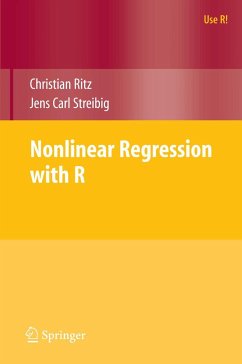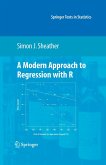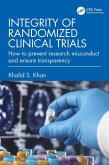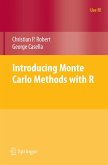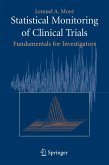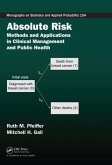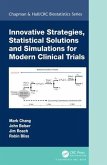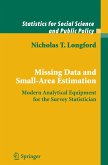- Coherent and unified treatment of nonlinear regression with R.
- Example-based approach.
- Wide area of application.
R is a rapidly evolving lingua franca of graphical display and statistical analysis of experiments from the applied sciences. Currently, R offers a wide range of functionality for nonlinear regression analysis, but the relevant functions, packages and documentation are scattered across the R environment. This book provides a coherent and unified treatment of nonlinear regression with R by means of examples from a diversity of applied sciences such as biology, chemistry, engineering, medicine and toxicology. R. Subsequent chapters explain the salient features of the main fitting function nls (), the use of model diagnostics, how to deal with various model departures, and carry out hypothesis testing. In the final chapter grouped-data structures, including an example of a nonlinear mixed-effects regression model, are considered.
- Example-based approach.
- Wide area of application.
R is a rapidly evolving lingua franca of graphical display and statistical analysis of experiments from the applied sciences. Currently, R offers a wide range of functionality for nonlinear regression analysis, but the relevant functions, packages and documentation are scattered across the R environment. This book provides a coherent and unified treatment of nonlinear regression with R by means of examples from a diversity of applied sciences such as biology, chemistry, engineering, medicine and toxicology. R. Subsequent chapters explain the salient features of the main fitting function nls (), the use of model diagnostics, how to deal with various model departures, and carry out hypothesis testing. In the final chapter grouped-data structures, including an example of a nonlinear mixed-effects regression model, are considered.
From the reviews:
"The Use R! series published by Springer is a wonderful thing. There is nothing else like it, and as far as I know there has never been anything like it, certainly not for open source software.... This book by Ritz and Streibig is a fine example. It documents, explains, and illustrates in considerable detail the venerable nls() function, available both in S and R, ... a mini-course in nonlinear regression.... Books of this form are ideal for self-study,.... My guess is that about 95% of the experimenters or researchers using this book will think that the material is quite sufficient for their needs, and will not be interested in further theoretical studying. That, I think, is actually one of its greatest strengths. ... In summary I think the book is excellent, and eminently useful. I hope it will serve as a model for documenting more of the larger R functions and packages." (Jan de Leeuw, Journal of Statistical Software, 2009).
"Readership: Under- and post-graduate students of statistics and of applied disciplines in biology, chemistry, engineering, fisheries science, medicine and toxicology. ... The scope and topic of this book are in the title and the authors take as their starting point the function nls() and subsequently, related functions in R. ... I strongly recommend this book - if you are a young scientist ... then this book will save you hours of wasted exploration and investigation to find the allusive solution to your nonlinear estimation problem." (C. M. O'Brien, International Statistical Review, Vol. 77 (3), 2009)
"...A brief and focused book in Springer's 'Use R!' series. ...The information about nonlinear regression methodology and advice on how to use it is accurate and useful; the examples are novel and effective ... and the authors provide enough information for practitioners who have little experience with nonlinear regression to begin to fit simple nonlinear models and draw inferences fromthem. ... Useful as a secondary text for an applied course on non-linear regression, providing students a tutorial on implementation in R and even some exercises that could be used in such a course or for self-study. I congratulate Ritz and Steibig on a informative and well-written little book. " (The American Statistician, February 2010, Vol. 64 No.1)
"The preface of this book clearly spells out its intended purpose: it is a how-to book on the use of the nls function in R, rather than a textbook on nonlinear regression. As such, it is intended as a reference for readers with some past experience with R and a reasonable working knowledge of linear regression, or as a supplementary text for a course on nonlinear regression. It serves both purposes pretty well and I judge it to be a handy little book... ." (Biometrics, Summer 2009, 65, 1001)
"The Use R! series published by Springer is a wonderful thing. There is nothing else like it, and as far as I know there has never been anything like it, certainly not for open source software.... This book by Ritz and Streibig is a fine example. It documents, explains, and illustrates in considerable detail the venerable nls() function, available both in S and R, ... a mini-course in nonlinear regression.... Books of this form are ideal for self-study,.... My guess is that about 95% of the experimenters or researchers using this book will think that the material is quite sufficient for their needs, and will not be interested in further theoretical studying. That, I think, is actually one of its greatest strengths. ... In summary I think the book is excellent, and eminently useful. I hope it will serve as a model for documenting more of the larger R functions and packages." (Jan de Leeuw, Journal of Statistical Software, 2009).
"Readership: Under- and post-graduate students of statistics and of applied disciplines in biology, chemistry, engineering, fisheries science, medicine and toxicology. ... The scope and topic of this book are in the title and the authors take as their starting point the function nls() and subsequently, related functions in R. ... I strongly recommend this book - if you are a young scientist ... then this book will save you hours of wasted exploration and investigation to find the allusive solution to your nonlinear estimation problem." (C. M. O'Brien, International Statistical Review, Vol. 77 (3), 2009)
"...A brief and focused book in Springer's 'Use R!' series. ...The information about nonlinear regression methodology and advice on how to use it is accurate and useful; the examples are novel and effective ... and the authors provide enough information for practitioners who have little experience with nonlinear regression to begin to fit simple nonlinear models and draw inferences fromthem. ... Useful as a secondary text for an applied course on non-linear regression, providing students a tutorial on implementation in R and even some exercises that could be used in such a course or for self-study. I congratulate Ritz and Steibig on a informative and well-written little book. " (The American Statistician, February 2010, Vol. 64 No.1)
"The preface of this book clearly spells out its intended purpose: it is a how-to book on the use of the nls function in R, rather than a textbook on nonlinear regression. As such, it is intended as a reference for readers with some past experience with R and a reasonable working knowledge of linear regression, or as a supplementary text for a course on nonlinear regression. It serves both purposes pretty well and I judge it to be a handy little book... ." (Biometrics, Summer 2009, 65, 1001)

